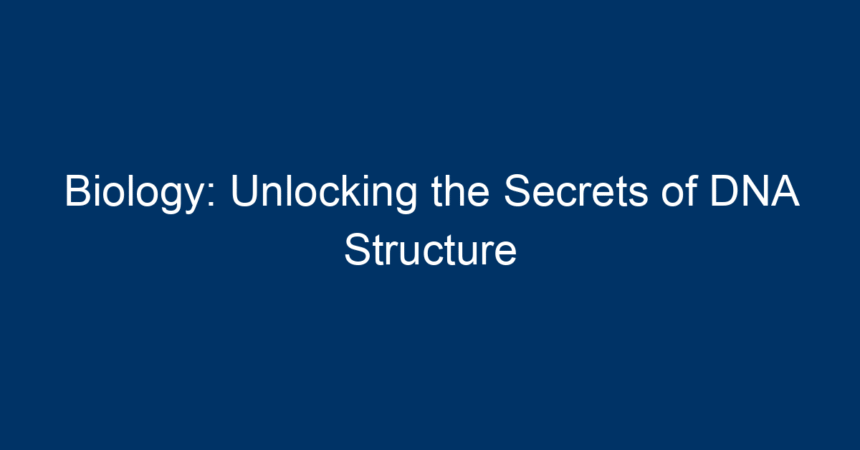In the fascinating world of biology, the structure of DNA stands as a cornerstone of understanding life itself. DNA, or deoxyribonucleic acid, is not just a molecule; it’s a blueprint that has dictated the development, functioning, and reproduction of every living organism on Earth. Its intricate design plays a pivotal role in the transmission of genetic information, making the study of DNA essential for anyone interested in the life sciences. In this article, we will delve into the remarkable structure of DNA, explore its significance in biology, and discuss how unlocking its secrets can deconstruct the complexities of life.
What is DNA?
The Basics of DNA
At its core, DNA is a long chain of nucleotides—each comprised of a sugar, a phosphate group, and a nitrogenous base. The sequence of these nucleotides encodes genetic information, much like letters forming words in a book. Structurally, DNA is a double helix, a term that describes its shape, which resembles a twisted ladder. This unique configuration allows DNA to store genetic information in a compact form while also safeguarding it against damage.
The Key Components of DNA
- Nucleotides: The building blocks of DNA, containing an adenine (A), cytosine (C), guanine (G), or thymine (T) base.
- Double Helix Structure: Formed by two strands coiling around each other, connected by base pairs that hold the strands together.
- Base Pairing: The rules of base pairing, A with T and C with G, are crucial for DNA replication and transcription.
The Discovery of DNA Structure
A Historical Overview
The journey to understanding DNA began in the mid-20th century. Key figures such as James Watson and Francis Crick, along with Rosalind Franklin’s pioneering X-ray diffraction images, culminated in the discovery of the double helix structure in 1953. This breakthrough not only revealed the architecture of DNA but also opened doors to understanding genetic inheritance, paving the way for modern genetics.
The Importance of This Discovery
The unveiling of DNA’s structure is arguably one of the most significant achievements in biology. It allowed scientists to comprehend how traits are inherited, leading to advancements in fields such as molecular biology, genetics, and biotechnology. Moreover, it set the stage for the development of techniques like DNA sequencing and genetic engineering.
The Role of DNA in Biology
Genetic Information and Heredity
DNA is fundamental to inheritance. Through the processes of mitosis and meiosis, genetic information is passed from parent to offspring. This transfer of information is crucial for maintaining species characteristics and ensuring biodiversity.
Gene Expression
Understanding DNA structure aids in exploring how genes are expressed. Genes are segments of DNA that encode proteins, the workhorses of the cell. The process of gene expression involves transcription (where DNA is converted into mRNA) and translation (where mRNA is translated into protein). Disruptions in this process can lead to diseases, highlighting the importance of DNA’s integrity in biology.
Evolution and Adaptation
The structure of DNA allows for mutations, which are changes in the nucleotide sequence. While some mutations can be harmful, others provide organisms with advantageous traits that can lead to evolution. The study of DNA has, therefore, been instrumental in understanding evolutionary biology, allowing scientists to trace lineage and speciation.
Unraveling DNA Structure: Techniques and Technologies
DNA Sequencing
With advancements in technology, DNA sequencing has revolutionized biology. Techniques such as Sanger sequencing and Next-Generation Sequencing (NGS) enable researchers to read genetic codes rapidly and accurately. This information is vital for numerous applications, including disease diagnosis, genetic research, and personalized medicine.
CRISPR Technology
CRISPR (Clustered Regularly Interspaced Short Palindromic Repeats) is another groundbreaking technique rooted in our understanding of DNA. This revolutionary gene-editing technology allows scientists to modify DNA sequences with precision. It holds immense potential for treating genetic disorders, improving crop resistance, and even combating infectious diseases.
Bioinformatics
The integration of biology with computer science has birthed bioinformatics, a field dedicated to storing, analyzing, and interpreting biological data. With DNA sequences being vast and complex, bioinformatics plays a critical role in modern biology, enabling comprehensive studies of genetic information and its implications on health and disease.
Ethical Considerations in DNA Research
Genetic Privacy
As we unravel the secrets of DNA, ethical concerns arise. The potential to edit genes and the availability of genetic information leads to questions about privacy and ownership. Should individuals have the right to control access to their genetic data? Who is responsible if genetic information is misused?
Designer Babies and Genetic Engineering
The concept of "designer babies," where genetic attributes are selected or modified before birth, raises moral dilemmas. While the potential for eradicating genetic diseases is promising, the ethical implications of enhancing human traits cannot be ignored. It blurs the lines between natural evolution and human intervention.
Striking a Balance
Navigating the intersection of technology, ethics, and biology requires careful consideration. Establishing guidelines and ensuring transparency in genetic research is essential for maintaining public trust and advancing the field responsibly.
Conclusion: The Future of DNA Research in Biology
As we continue to explore the complexities of DNA structure and function, the implications for biology are boundless. From understanding heredity to revolutionizing medicine, the secrets of DNA open doors to new horizons in scientific research.
Actionable Insights
- Stay Informed: Follow advancements in genetics and DNA research to understand the ongoing impact of these discoveries on society.
- Get Involved: Consider participating in local or online biology groups to discuss and explore DNA-related topics with like-minded individuals.
- Educate Others: Share your knowledge of DNA structure and its significance in biology with friends and family, fostering a community interested in biological sciences.
The journey into understanding DNA is far from over. As science advances, our grasp on life itself will only deepen, ultimately reshaping our understanding of biology and the very essence of what it means to be alive.




